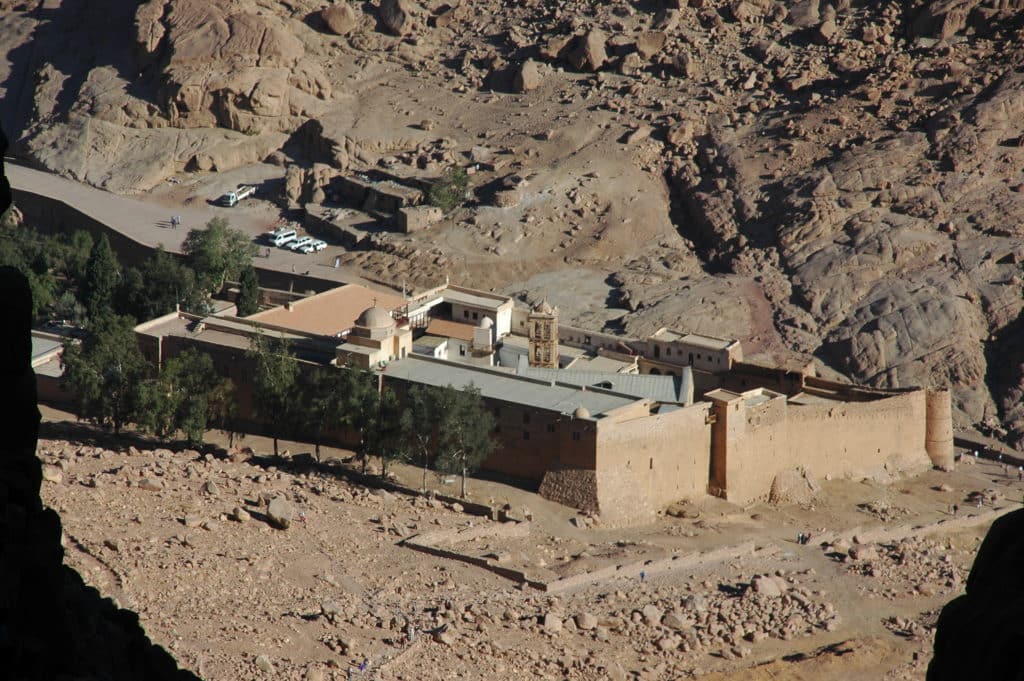Table of Contents
Climbing Mt. Sinai
I see now why they’re called the “steps of repentance”. Some people learn the hard way why they’re so aptly named. Luckily our guide explained that there was a second way to the top of the mountain where Moses received the Ten Commandments, on the longer, more gradual, Camel Path.
It was 2 a.m. when we started from the base of the mountain near St. Catherine’s Monastery. We would spend the next 2½ hours climbing Mt. Sinai, or Jebel Musa (Mt. Moses) as the Arabs call it, the moonlight enough to steer us up the well-worn path to the summit.

At the summit I was shocked to see hundreds of others camped out in anticipation of the sunrise. We all waited patiently, chilly even under warm blankets, for the most dramatic and divine sunrise I’ve ever witnessed, the sun breaking over the pointed mountains in this incredibly barren landscape.
We descended down a steep ravine by way of the 3,750 “steps of repentance”, illuminated in a striking orange glow by the morning sun. The steps were so named by one of the monastery’s monks, and walked by those in need of penance. We certainly felt compassion for those few on their way up.
The Monastery
Most of the way down we could see our destination below: St. Catherine’s Monastery. Located at the foot of Mt. Sinai, it is said to be the oldest continuously functioning Christian monastery in the world and has been designated a UNESCO world heritage site.
Despite its remote desert location, the monastery and mountain hike are extremely popular, the hardest decision not being whether to go or not, but to go for sunrise or sunset. The morning I visited, I pushed through the narrow monastery doors with bus loads of Russian package pilgrims and European and American tourists.

We spilled inside through the massive fortifications that have preserved this monastery for more than fourteen centuries. We immediately moved towards the Basilica of the Holy Transfiguration, built in the sixth century by Eastern Emperor Justinian, where the liturgy is still observed today. A huge mosaic of Christ in his glorious transfiguration adorns the apse.
Nearby, the monastery library holds the second largest collection of early codices and manuscripts in the world, preserving more than any other place except the Vatican library. The monastery also holds a significant collection of religious treasures, including an important collection of icons.
As I exited the basilica I saw the Burning Bush. Reading Old Testament stories, especially as a child, I always imagined the events; the people, places, and things in the stories as ancient history. Before my Middle East trip I was excited to learn that some of these places actually do still exist today and from the outset of my journey to the Holy Lands, St. Catherine’s Monastery was on my must-see list.
Crowding around the bush, pilgrims cut pieces from the dangling branches, which hung over everyone’s head, just as it has for centuries. As tradition states, it is the original bush that Moses saw, which was “on fire, but was not consumed by the flames,” as we know from Exodus.
There is also a mosque inside the monastery which symbolizes the mutual religious tolerance surrounding St. Catherine’s. It is known to be the only mosque in the world inside of a sacred Christian site and is still used by the monks’ Bedouin groundskeepers.
Catherine of Alexandria
Although officially called The Sacred and Imperial Monastery of the God-Trodden Mount of Sinai, first dedicated to the prophets Moses and Elias, the monastery became associated with St. Catherine when her bones were said to have been transported here by angels and discovered by monks around 800.
As a young woman, Catherine devoted herself to the pursuit of knowledge, and in addition to being highly learned in philosophy and theology, she was very beautiful and sexually pure as well. However, it was her faith to which she was most dedicated, and because of her enduring love of Jesus Christ, she was tortured, starved, and finally sentenced to death.

Pleading with the Roman Emperor Maxentius to no longer persecute Christians, Catherine was unsuccessful. But she did well in converting his wife, the Empress, and many others. She was ultimately sentenced to death by the spiked wheel, which has since become known as the Catherine Wheel, but during the execution, it miraculously broke down and she was then beheaded.
St. Catherine’s feast day is celebrated on the 25th of November and the monastery that takes her name survives today, as an important reserve of early Christian art, architecture, and manuscripts.
Planning your visit
The oldest continuous and active Christian monastery is located in the heart of the Sinai Peninsula, in modern day Egypt. It’s easy to join one of the many group tours from any of the resorts in Sinai. For those who don’t wish to hike up to the summit, camels can be rented at the foot of the mountain.
Getting there
St. Catherine’s Monastery and Mt. Sinai can easily be included on a trip to Egypt by way of Cairo, or while visiting the Holy Land, via Jerusalem. The Taba-Elat border crossing from Israel to Sinai, Egypt remains open for travelers in the region. Plan at least an eight-hour trip by car or bus from either Cairo or Jerusalem.




Pingback: Photo of the Week: Sinai Peninsula Egypt | GoMad Nomad Travel